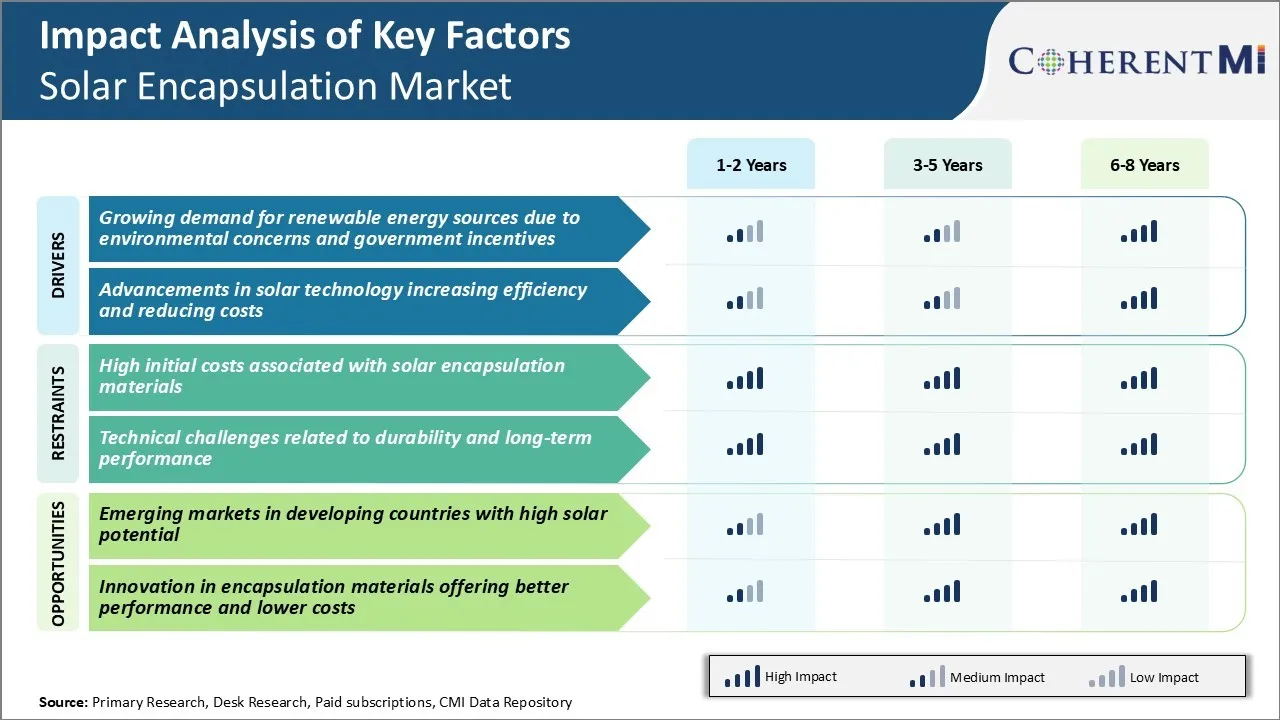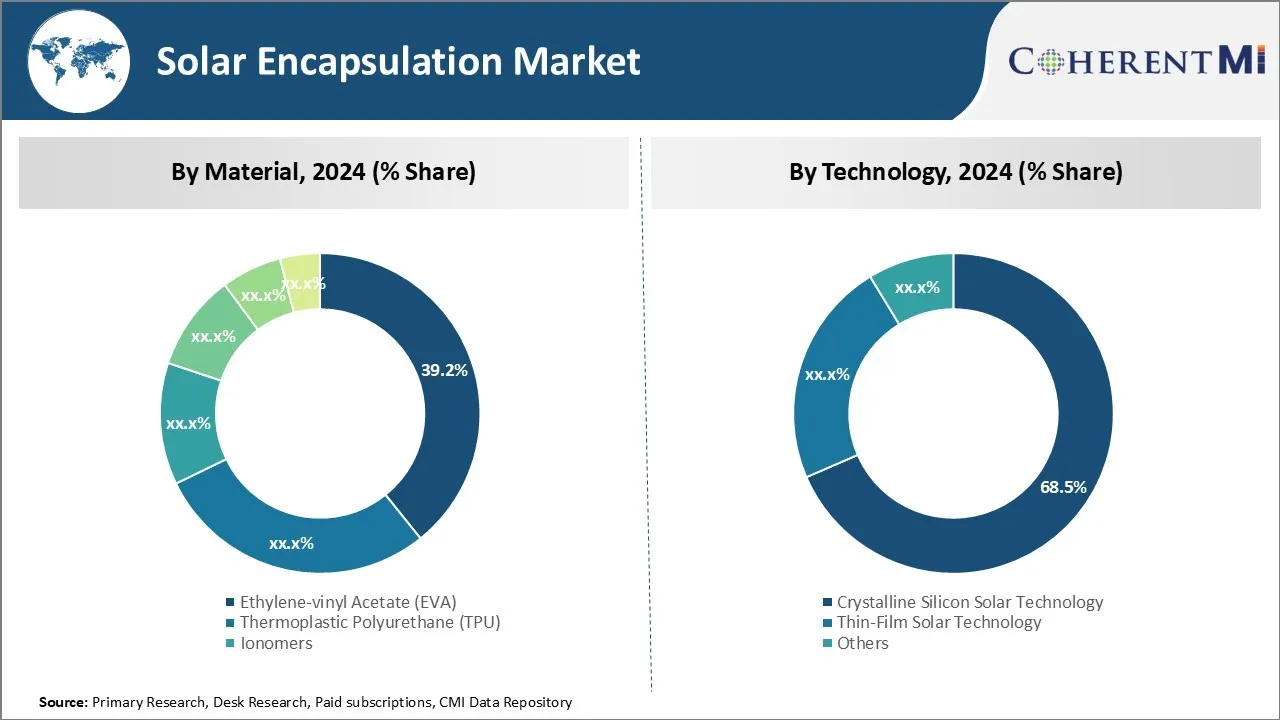Solar Encapsulation Market SIZE AND SHARE ANALYSIS - GROWTH TRENDS AND FORECASTS (2024 - 2031)
Solar Encapsulation Market is segmented By Material (Ethylene-vinyl Acetate (EVA), Thermoplastic Polyurethane (TPU), Ionomers, Polydimethylsiloxane, P....
Solar Encapsulation Market Size
Market Size in USD Bn
CAGR8.15%
| Study Period | 2024 - 2031 |
| Base Year of Estimation | 2023 |
| CAGR | 8.15% |
| Market Concentration | High |
| Major Players | Arkema S.A., Specialized Technology Resources, RenewSys, Solutia Inc., Mitsui Chemicals Tohcello, Inc. and Among Others. |
please let us know !
Solar Encapsulation Market Analysis
The solar encapsulation market is estimated to be valued at USD 5.44 Bn in 2024 and is expected to reach USD 9.41 Bn by 2031, growing at a compound annual growth rate (CAGR) of 8.15% from 2024 to 2031. The solar encapsulation market is witnessing positive trends due to the increasing demand for renewable energy sources across the globe.
Solar Encapsulation Market Trends
Market Driver - Growing Demand for Renewable Energy Sources due to Environmental Concerns and Government Incentives
With concerns about the impact of fossil fuels on climate change rising globally, many nations are focusing on developing renewable energy sources to reduce their carbon footprint. In the recent past, various studies conducted by reputed organizations like UN Environment Programme and IPCC have warned about catastrophic consequences of climate change. This has created widespread awareness among public and policymakers about the need to switch to cleaner sources of electricity.
Solar energy, which is carbon-free and most abundant, is considered as one of the front runners to replace fossil fuels. Many developed and developing countries have announced bold targets of achieving net-zero emissions and sourcing substantial portions of their power needs from renewable sources by mid-century.
At the same time, others provide low interest loans, tax credits, and feed-in-tariffs to make solar projects financially viable for developers and consumers. These inducements have made rooftop solar systems and utility-scale photovoltaic installations highly lucrative propositions. This is expected to boost growth of the solar encapsulation market.
Market Driver - Advancements in Solar Technology Increasing Efficiency and Reducing Costs
Continuous technological progress is expanding the potential of solar energy worldwide. Significant advancements are being made to improve efficiency and bring down costs of photovoltaic modules and associated components like solar encapsulants.
Polysilicon solar cells have remarkably increased their efficiency over the decades through R&D. While first generation cells used to have efficiencies under 10%, current commercial monocrystalline cells easily achieve efficiencies exceeding 22%. Moreover, solar is now increasingly finding acceptance as distributed rooftop installations instead of large-scale parks alone.
Rapid growth in residential solar segments in the solar encapsulation market is due to growing affordability of systems for homeowners. Flexible and lightweight building integrated photovoltaics are making further inroads. Such diversification drives volumes for advanced solar encapsulation materials industry. Overall, continual breakthroughs in conversion efficiency and reductions in manufacturing costs are extending photovoltaics as a versatile renewable resource with vast untapped opportunities yet to be harnessed. This acts as fundamental driver propelling global demand in solar encapsulation market.

Market Challenge - High Initial Costs Associated with Solar Encapsulation Materials
One of the key challenges facing the solar encapsulation market is the high initial costs associated with the raw materials used in encapsulation sheets and films. The specialized nature of solar encapsulation polymers means they need to be engineered specifically for withstanding UV exposure, high temperatures, and moisture ingress.
Additionally, solar encapsulation polymers also involve complex multi-stage production workflows such as compounding, casting and curing which pushes up capital expenditure for manufacturers. The high costs of raw materials, production, and long product development cycles are passed on to solar module manufacturers and end customers. This impedes the large-scale adoption of solar energy especially in price-sensitive, solar encapsulation markets.
Market Opportunity: Emerging Markets in Developing Countries with High Solar Potential
One of the key opportunities for the solar encapsulation materials market lies in the emerging economies of developing countries that have high solar resource potential. Countries such as India, Brazil, Mexico, and many nations in the Middle East and North Africa regions have optimal solar insolation levels year-round. However, a majority of the population in these areas remains underserved from an energy access perspective as conventional grid-based infrastructure has struggled to expand to remote areas.
As local solar manufacturing capacities are also being strengthened in these regions, the demand for cost-competitive encapsulation materials will see a parallel rise. Technology transfer from established global encapsulant producers can aid local manufacturing. This presents lucrative prospects for encapsulant suppliers to tap emerging markets and gain larger share in the solar encapsulation market.
Key winning strategies adopted by key players of Solar Encapsulation Market
Focus on technological innovation: Companies are investing heavily in R&D to develop more efficient and durable encapsulation materials.
Strategic partnerships and acquisitions: Players are partnering with or acquiring companies that provide complementary technologies to expand their product portfolio.
Target emerging solar markets: As the demand for solar energy grows in developing countries, players are focusing on markets like India, Middle East, Latin America and Africa.
Reduce manufacturing costs through economies of scale: Top players from solar encapsulation market are expanding production capacities globally to achieve optimum capacity utilization and gain cost leadership.
Focus on high margin specialized applications: Companies in solar encapsulation market are innovating encapsulation materials for specialized solar applications like BIPV, floating solar, and concentrator PV that command premium pricing.
Segmental Analysis of Solar Encapsulation Market
Insights, By Material: Cost-Effectiveness and Stability Drive EVA's Dominance
In terms of material, ethylene-vinyl acetate (EVA) contributes 39.2% share of the solar encapsulation market owning to its cost-effectiveness and stability. EVA encapuslates around 70% of the global solar module market as it is one of the most inexpensive options. Being comprised of ethylene and vinyl acetate, EVA sheets are simple to manufacture which keeps production costs low.
EVA is also remarkably stable, retaining its flexibility even under varying environmental conditions for decades. Its resistance to moisture, heat, and ultraviolet radiation make it ideally suited to protect photovoltaic cells. While other materials like ionomers and thermoplastic polyurethane are gaining ground, EVA remains the standard choice especially for commercial and utility-scale projects due to its robustness and affordability.

Insights, By Technology: Silicon Technology Scaling Drives Continued Market Share
In terms of technology, crystalline silicon solar technology contributes 68.5% share of the solar encapsulation market owing to ongoing innovations lowering silicon costs. Crystalline silicon cells continue to dominate as improvements in manufacturing processes have significantly reduced thickness requirements.
Transitioning to technologies like PERC and HJT have boosted efficiencies while decreasing silicon usage. This scaling of crystalline silicon technology combined with robust supply chains have kept costs declining. Despite advances in thin-film technologies, crystalline silicon maintains over 90% market share and is projected to continue leading the way as costs approach wafer-based limits in the coming years.
Insights, By Application: Expanding EV Adoption Propels Growth in Automotive Applications
In terms of application, automotive segment contributes the highest share of the solar encapsulation market spurred by increasing electric vehicle production. Solar panels are increasingly used in vehicle integrated photovoltaics to supplement traditional charges or power ancillary features. As automakers race to electrify their fleets and consumer EV adoption expands, the potential for deployed panel area is vast.
Recent initiatives have accelerated this transition, driving automaker investments in advanced solar technology integration. Features like sunroofs and rear spoilers are being re-engineered to harvest photons. If trends hold, the automotive market may overtake construction in the next five years as a solar encapsulation market leader.
Additional Insights of Solar Encapsulation Market
- The integration of solar encapsulation materials in building-integrated photovoltaics (BIPV) has been a significant trend, allowing for the seamless incorporation of solar panels into building structures.
- The automotive industry's adoption of solar technologies for electric vehicles has increased the demand in the solar encapsulation market.
- The Asia-Pacific region accounted for over 40% market share in 2020, driven by countries like China, India, and Japan investing heavily in solar infrastructure.
- Technological advancements have reduced the cost of solar encapsulation by approximately 15% over the past five years.
- The ethylene vinyl acetate (EVA) material segment led the market in 2023 due to its durability, UV resistance, and performance under varying conditions.
Competitive overview of Solar Encapsulation Market
The major players operating in the solar encapsulation market include Arkema S.A., Specialized Technology Resources, RenewSys, Solutia Inc., Mitsui Chemicals Tohcello, Inc., Borealis AG, Kuraray Co., Ltd, Hanwha Corporation, Targray Technology International Inc., First Solar, Inc., STR Holdings, Inc., Bridgestone Corporation, Hangzhou First PV Material Co., Ltd., 3M Company, DowDuPont Inc., and Saint-Gobain S.A.
Solar Encapsulation Market Leaders
- Arkema S.A.
- Specialized Technology Resources
- RenewSys
- Solutia Inc.
- Mitsui Chemicals Tohcello, Inc.
Solar Encapsulation Market - Competitive Rivalry, 2024

Solar Encapsulation Market
(Dominated by major players)
(Highly competitive with lots of players.)
Recent Developments in Solar Encapsulation Market
- The integration of solar encapsulation materials in building-integrated photovoltaics (BIPV) has been a significant trend, allowing for the seamless incorporation of solar panels into building structures.
- The automotive industry's adoption of solar technologies for electric vehicles has increased the demand in the solar encapsulation market.
- The Asia-Pacific region accounted for over 40% market share in 2020, driven by countries like China, India, and Japan investing heavily in solar infrastructure.
- Technological advancements have reduced the cost of solar encapsulation by approximately 15% over the past five years.
- The ethylene vinyl acetate (EVA) material segment led the market in 2023 due to its durability, UV resistance, and performance under varying conditions.
Solar Encapsulation Market Segmentation
- By Material
- Ethylene-vinyl Acetate (EVA)
- Thermoplastic Polyurethane (TPU)
- Ionomers
- Polydimethylsiloxane
- Polyvinyl Butyral
- Polyolefin
- By Technology
- Crystalline Silicon Solar Technology
- Thin-Film Solar Technology
- Others
- By Application
- Automotive
- Construction
- Electronics
- Others

Would you like to explore the option of buying individual sections of this report?
Frequently Asked Questions :
How big is the solar encapsulation market?
The solar encapsulation market is estimated to be valued at USD 5.44 Bn in 2024 and is expected to reach USD 9.41 Bn by 2031.
What are the key factors hampering the growth of the solar encapsulation market?
High initial costs associated with solar encapsulation materials and technical challenges related to durability and long-term performance are the major factors hampering the growth of the solar encapsulation market.
What are the major factors driving the solar encapsulation market growth?
Growing demand for renewable energy sources due to environmental concerns and government incentives and advancements in solar technology increasing efficiency and reducing costs are the major factors driving the solar encapsulation market.
Which is the leading material in the solar encapsulation market?
The leading material segment is ethylene-vinyl acetate (EVA).
Which are the major players operating in the solar encapsulation market?
Arkema S.A., Specialized Technology Resources, RenewSys, Solutia Inc., Mitsui Chemicals Tohcello, Inc., Borealis AG, Kuraray Co., Ltd, Hanwha Corporation, Targray Technology International Inc., First Solar, Inc., STR Holdings, Inc., Bridgestone Corporation, Hangzhou First PV Material Co., Ltd., 3M Company, DowDuPont Inc., and Saint-Gobain S.A. are the major players.
What will be the CAGR of the solar encapsulation market?
The CAGR of the solar encapsulation market is projected to be 8.15% from 2024-2031.